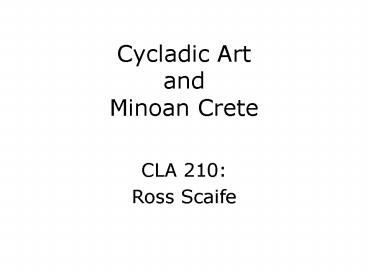Cycladic Art and Minoan Crete - PowerPoint PPT Presentation
1 / 41
Title:
Cycladic Art and Minoan Crete
Description:
Geography of the region. Chronology. Cycladic art (briefly!) Old and New Palaces. Mythology ... Geography. Mediterranean and Aegean. Cyclades. Crete (Knossos ... – PowerPoint PPT presentation
Number of Views:469
Avg rating:3.0/5.0
Title: Cycladic Art and Minoan Crete
1
Cycladic Art andMinoan Crete
- CLA 210
- Ross Scaife
2
Topics
- Geography of the region
- Chronology
- Cycladic art (briefly!)
- Old and New Palaces
- Mythology
- Basic Characteristics of Knossos
3
Useful references
- Rutter, J. The Prehistoric Archaeology of the
Aegean (1998) ON-LINE ONLY http//projects.dartmou
th.edu/history/bronze_age/ - Doumas, C. The Wall Paintings of Thera (1992)
- Feuer, B. Mycenaean Civilization A Research
Guide (1996) - Immerwahr, S. Aegean Painting in the Bronze Age
(1990) - Marinatos, S. Crete and Mycenae (1960)
- Morgan, L. The miniature wall paintings of Thera
a study in Aegean culture and iconography (1988)
4
Geography
- Mediterranean and Aegean
- Cyclades
- Crete (Knossos and Phaistos)
- Athens and Mycenae
5
Mediterranean Region
6
Greece, Crete, and the Aegean
7
A few of the islands in the Cyclades note Delos
and Santorini especially
8
Relative and Absolute Chronologies
- Cycladic figurines 3200-2000 BCE
- Old Palace period on Crete starts c. 2000 (
Middle Minoan I and II) - New Palace period starts c. 1700 ( Middle
Minoan III, Late Minoan I) - Post-palace period starts c. 1500( late Minoan
II and III)
9
Cycladic Figurines
- Date from 3200-2000 BCE
- Exact provenience often uncertain much looting
of Cycladic graves - Mostly females FAF type common
- Few males, some musicians, drinkers
- Fiddle figurines some of the earliest
- Goulandris Museum of Cycladic Art
http//www.cycladic.gr/permanent/permanent.htm
10
Cycladic Folded Arm Figurine It is an abstract
representation of the female body with an
emphasis on slender forms and linear details. The
arms are typically folded above the belly which
seems swollen, perhaps as an indication of
pregnancy. An incised triangle marks the pubic
area. Such figurines were perhaps meant to
represent deities associated with fertility or
motherhood. Many were found in graves, so they
may have played a part in funerary rituals. --
Goulandris Museum
11
Fiddle figurine
Frying Pan
12
(No Transcript)
13
Relative and Absolute Chronologies
- Cycladic figurines 3200-2000 BCE
- Old Palace period on Crete starts c. 2000 (
Middle Minoan I and II) - New Palace period starts c. 1700 ( Middle
Minoan III, Late Minoan I) - Post-palace period starts c. 1500( late Minoan
II and III)
14
Arthur Evans worked at Knossos from 1900-1935
Evans, Arthur, Sir. The palace of Minos a
comparative account of the successive stages of
the early Cretan civilization as illustrated by
the discoveries at Knossos. 4 vols. London,
1921-35.
15
Major Palaces at Knossos, Phaistos, Mallia,
Kato Zakro
16
Phaistos(aerial view)
17
(No Transcript)
18
Central court at Phaistos
19
Lustral basin and paved NW court at Phaistos
20
Kamares Ware Pottery (Old Palace Period)
21
Kamares Ware Pottery (Old Palace Period, MM
II 1900-1700)
22
Kamares Ware Pottery (Old Palace Period, MM
II 1900-1700)
23
Knossos
24
Imaginative reconstruction of Knossos
25
Old and New Palaces
- Common Characteristics
- Central courts, theatral spaces, roads
- Light wells and colonnades
- Storage magazines with giant pithoi
- Writing for administration of economy
- Linear A (MMII to LMI) Linear B (later)
- Mysterious symbols here and there
26
Road leading to NW entrance steps at Knossos
27
Road leading to NW entrance steps at Knossos
28
Light well at Knossos (note inverted column)
29
Pithoi (s. pithos) in a storage magazine at
Knossos
30
Mythology
- Minos and Pasiphae
- Pasiphae and Daedalus
- Ariadne and the Minotaur
- Daedalus and the Labyrinth
- Theseus, Ariadne, and Aegeus
31
Pasiphae and Daedalus
Roman-era painting from Pompeii
32
Pasiphae and the Minotaur
33
Labyrinth the place of the labrys (-nthos and
ossos terminations indicate pre-Indo-european
place names)
34
(No Transcript)
35
Theseus killing the Minotaur
(Attic black figure vase paintings)
36
Representative Minoan Art
- Pottery
- Kamares Ware (Old Palace)
- Marine Style (LM I)
- Floral Style (LM I)
- Murals
- Cat and Bird Fresco
- Lilies from Amnisos
- Bull leaping
- Dancing Girl
37
Marine Style (LM I 1500-1450) Pilgrims Flask
(water jug or canteen)
38
Floral Style (LM I)
39
Cat and Bird fresco from Hagia Triada. Late
Minoan IA, c. 1550 BC
40
Lilies from Amnisos (a port of Knossos, c.
1700-1500)
41
Next
- Bulls and bull-leaping at Knossos
- Minoan women and Minoan religion
- Thera (Akrotiri)































